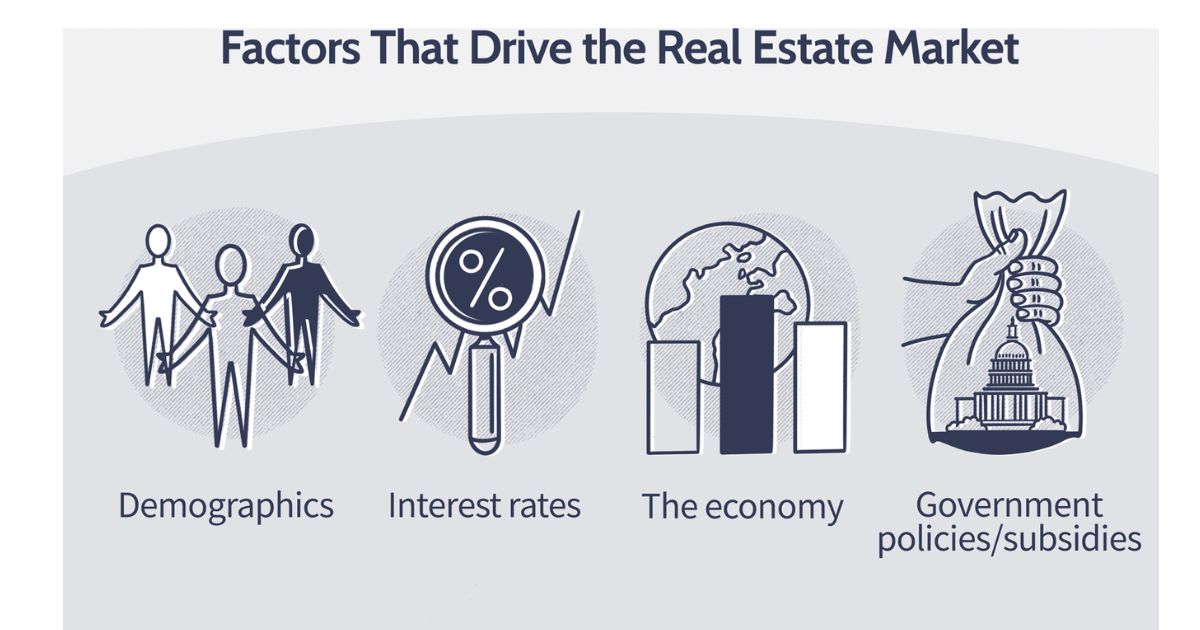Do you ever wonder what drives the supply in the real estate market? Well, here’s an interesting statistic for you: the primary factor that affects supply is population growth.
As the population increases, so does the demand for housing, which in turn impacts the supply available.
This article will delve into the various factors that influence supply in the real estate market, including interest rates, economic conditions, government regulations, housing market trends, construction activity, land availability, and market demand.
So, let’s explore together and gain a deeper understanding of this fascinating topic.
Key Takeaways
- Population growth is a key factor that primarily affects supply in the real estate market as it drives the demand for housing and leads to increased competition and higher prices due to limited supply.
- Interest rates also play a crucial role in influencing supply as low interest rates increase affordability and demand for real estate, while high interest rates decrease borrowing and demand for properties, directly impacting the overall dynamics of the real estate market.
- Economic conditions, such as the strength of the job market and economic uncertainty, affect consumer confidence and demand for housing, ultimately influencing the supply factors in the real estate market.
- Government regulations and policies, including land availability and zoning restrictions, shape the supply dynamics in the real estate market by influencing construction feasibility, land development, and overall availability of properties.
Population Growth
You’ll find that population growth has a significant impact on the supply of real estate in the market. As the population increases, the demand for housing also rises, resulting in a higher need for real estate properties.
According to recent data, the global population is projected to reach 9.7 billion by 2050, an increase of approximately 2 billion people from the current population. This exponential growth implies a substantial demand for housing, causing a strain on the supply of available real estate.
As a result, the limited supply leads to increased competition among buyers, driving up prices and making it more challenging for individuals to find affordable housing options. Therefore, population growth plays a crucial role in shaping the supply dynamics in the real estate market, influencing prices and availability.
This relationship between population growth and real estate supply sets the stage for exploring the next factor: interest rates.
Interest Rates
Undoubtedly, interest rates are a significant factor that impacts the supply in the real estate market.
When interest rates are low, it becomes more affordable for individuals and businesses to borrow money, leading to increased demand for real estate. This increased demand can result in a decrease in the supply of available properties, as they’re being purchased at a faster rate.
Conversely, when interest rates are high, borrowing becomes more expensive, and potential buyers are less likely to take out loans to purchase properties. This decrease in demand can lead to an increase in the supply of properties on the market.
Therefore, fluctuations in interest rates have a direct impact on the supply of real estate, influencing the overall dynamics of the market.
Economic Conditions
Considering the state of the economy, assessing economic conditions is crucial in understanding their impact on the supply in the real estate market. Economic conditions play a significant role in determining the level of supply in the real estate market. Here are four key ways in which economic conditions affect the supply:
- Job Market: The strength of the job market directly impacts the demand for housing. When the economy is thriving and job opportunities are abundant, more people are likely to enter the housing market, increasing the demand for properties.
- Consumer Confidence: Economic conditions greatly influence consumer confidence. During periods of economic uncertainty, potential buyers may be hesitant to invest in real estate, leading to a decrease in demand and subsequently affecting the supply.
- Interest Rates: Economic conditions, such as inflation and monetary policy, can influence interest rates. Higher interest rates can deter potential buyers from entering the market, reducing demand and impacting the supply of available properties.
- Economic Growth: The overall economic growth of a region has a direct correlation with the supply of real estate. Strong economic growth attracts businesses and individuals, leading to increased demand for properties and subsequently impacting supply.
Understanding and monitoring economic conditions is crucial for real estate professionals and investors as it provides valuable insights into the factors that affect the supply in the market.
Government Regulations
If you’re wondering how government regulations impact the supply in the real estate market, there are several key factors to consider.
Government regulations play a significant role in shaping the supply of real estate by influencing land availability, development restrictions, and zoning regulations. These regulations aim to ensure sustainable growth, maintain environmental standards, and protect public interests.
For example, strict zoning laws may limit the construction of new residential units in certain areas, leading to a constrained supply and increased prices. Additionally, building codes and safety regulations can impact the cost and feasibility of construction projects, further affecting the supply of housing.
Understanding these government regulations, including the potential implications of selling property below market value, is crucial in assessing the overall supply dynamics in the real estate market. It’s important to grasp how such actions can influence housing inventory and pricing trends, as well as their impact on both buyers and sellers.
Transitioning into the subsequent section about ‘housing market trends’, these regulations interact with various other factors to shape the current trends in housing supply.
Housing Market Trends
To understand the current housing market trends, you should pay attention to both supply and demand factors. Here are four key trends shaping the real estate market:
- Low inventory: The supply of available homes is at historically low levels. This has led to increased competition among buyers, driving up prices.
- Urbanization: There’s a growing trend of people moving to cities, leading to increased demand for housing in urban areas. This has resulted in rising prices and limited supply in these regions.
- Remote work: The COVID-19 pandemic has accelerated the shift towards remote work. This has allowed people to live in locations outside of major cities, leading to increased demand in suburban and rural areas.
- Affordable housing crisis: Many cities are facing an affordable housing shortage, with a significant gap between supply and demand. This has resulted in rising housing costs and limited options for low-income individuals and families.
Understanding these housing market trends can help you make informed decisions when buying or selling a home.
Construction Activity
You may be wondering how construction activity affects the supply in the real estate market.
Well, the level of construction activity plays a crucial role in determining the supply of real estate properties available for sale or rent.
When construction activity is high, more new properties are being built, increasing the overall supply in the market. This can lead to a decrease in prices and more options for buyers or renters.
On the other hand, when construction activity is low, the supply of new properties is limited, which can result in higher prices and a decrease in options for potential buyers or renters.
Therefore, the level of construction activity directly impacts the supply dynamics in the real estate market.
As we delve into the next section about ‘land availability’, we’ll explore how this factor contributes to the overall supply equation.
Land Availability
But, if you’re wondering about land availability and how it affects the real estate market, there are several key factors to consider. Here’s what you need to know:
- Urbanization: The increasing demand for housing in urban areas puts pressure on available land. As cities expand, the supply of vacant land decreases, leading to higher property prices.
- Zoning regulations: Local government regulations dictate how land can be used. These zoning codes can restrict the development of certain areas, limiting the availability of land for real estate projects.
- Land use policies: Government policies can also impact land availability. For example, protection of environmentally sensitive areas or preservation of agricultural land can restrict the use of land for real estate development.
- Infrastructure development: The availability of land is also influenced by the presence of infrastructure such as roads, utilities, and public transportation. Areas with better infrastructure are more likely to attract real estate development, leading to increased land prices.
Understanding these factors is crucial for both real estate developers and potential homebuyers, as they directly influence the supply and affordability of properties in the market.
Market Demand
When it comes to determining the market demand for real estate, it’s important to consider your preferences and financial capabilities as a potential buyer or investor.
Understanding market demand requires analyzing various factors such as population growth, economic conditions, and consumer preferences.
Research shows that population growth plays a significant role in driving demand for real estate. Areas with increasing populations tend to experience higher demand for housing and commercial spaces.
Additionally, economic conditions such as employment rates and income levels impact the affordability of real estate, influencing market demand.
Consumer preferences also shape market demand, with factors such as location, amenities, and property size affecting the desirability of a property.
Frequently Asked Questions
How Does the Availability of Skilled Labor Impact the Supply in the Real Estate Market?
The availability of skilled labor greatly impacts the supply in the real estate market. When there is a shortage of skilled workers, it becomes difficult for developers to meet the demand for new housing, leading to a decrease in supply.
What Role Does Technology Play in Influencing the Supply of Real Estate?
Technology plays a significant role in influencing the supply of real estate. From online listings to virtual tours, technology has made it easier for buyers to access information and for sellers to reach a wider market, ultimately impacting the supply in the real estate market.
How Do Changes in Transportation Infrastructure Affect the Supply of Real Estate?
Changes in transportation infrastructure can have a significant impact on the supply of real estate. Improved transportation systems, such as new highways or public transit options, can increase accessibility to certain areas and stimulate development, leading to an increase in the supply of real estate.
What Impact Does Environmental Sustainability Have on the Supply of Real Estate?
Environmental sustainability has a significant impact on the supply of real estate. As more people prioritize eco-friendly living and governments implement regulations, demand for sustainable properties increases, influencing the availability of real estate options.
How Do Cultural and Societal Factors Influence the Supply of Real Estate?
Cultural and societal factors greatly influence the supply of real estate. They shape the demand for certain locations, architectural styles, and amenities. As people seek belonging and identity, these factors play a crucial role in shaping the real estate market.
Conclusion
In conclusion, when analyzing the factors that primarily affect supply in the real estate market, it’s evident that population growth, interest rates, economic conditions, government regulations, housing market trends, construction activity, land availability, and market demand all play significant roles.
These factors intertwine and create a complex web of influences, similar to the intricate threads of a tapestry. Understanding the interplay between these factors is crucial for making informed decisions in the real estate market.










